Dubai - The Burj Khalifa
last update: 09 May 2020
Our New Year trip for 2020 ran from late January 2020 to mid-March 2020 and involved 8 nights in Dubai and 43 nights in Phuket. We spent 3 nights in Dubai outward bounds, and 5 nights in Dubai on our return flight.
The first visit we booked during our first stay in Dubai was a visit to the Burj Khalifa. As of early 2020, it is the tallest structure and building in the world. As a structure it's taller than any mast, tower, chimney, pylon, minaret, etc. and it's also taller than any other building in the world. And it's twice as tall as the Empire State Building.
The visit experience is called 'At The Top', and there is a specific booking site for tickets, etc.
We booked the "Tea in the Clouds" option, at an eye-watering price (but you will probably only do it once …). And using the same website we also booked a lake ride to see up-close The Dubai Fountain.
Firstly I want to describe our visit, and then, as I love architecture, I will spend some time looking at how the Burj Khalifa was built.
Booking our visit
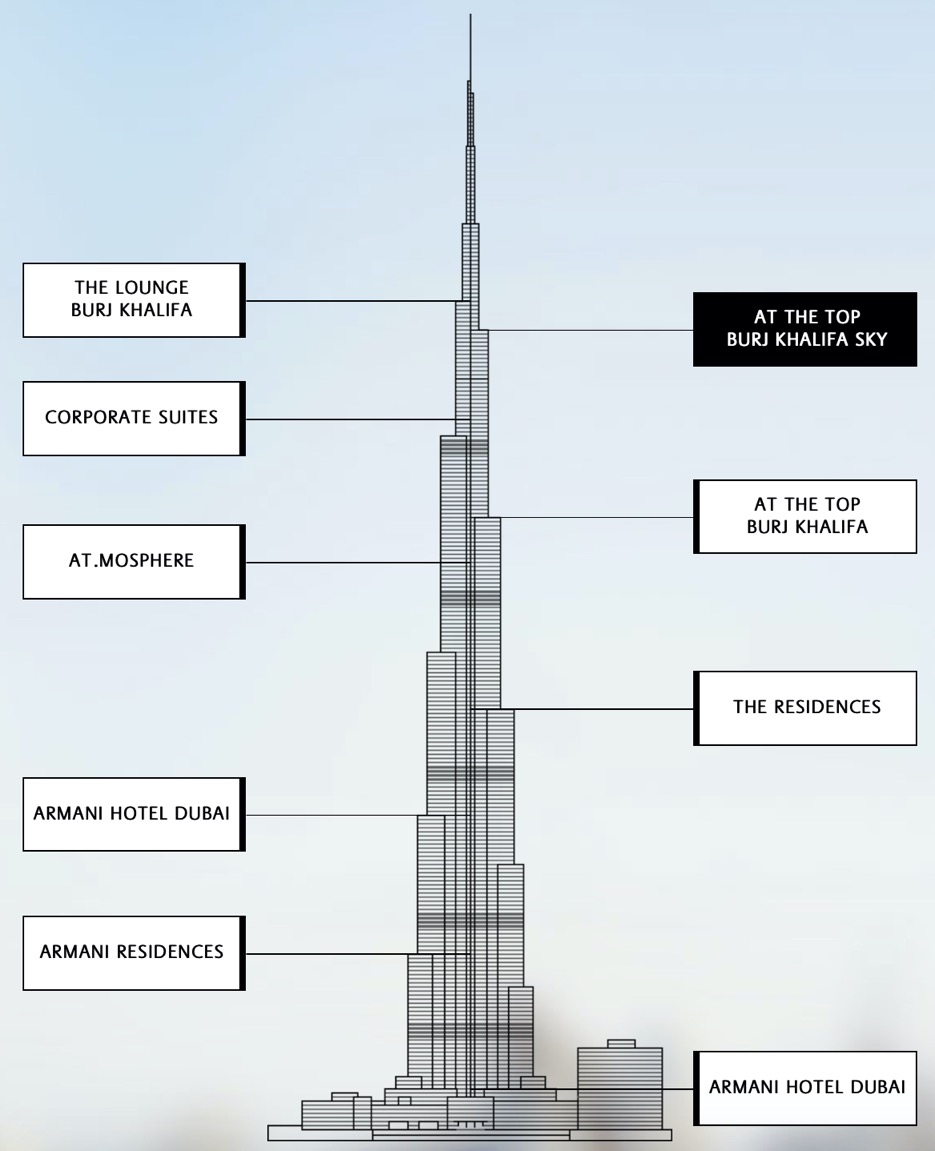
The 'visitor experience' can take a number of forms. The simplest is the observation decks at levels 124 and 125 (124 is an outdoor terrace). The next is the 'SKY' at level 148 with a 'premium lounge' and outdoor terrace. The best is 'The Lounge' on levels 152 and 154.
If you are going to visit the highest building in the world, you might as well visit the highest lounge in the world at 585 meters above ground level. So we pre-booked the "Tea in the Clouds" option for a total cost of AED 1,246 (or about 306€).
Our "Tea in the Clouds" receipt told us that we had to access the tower at ground level, i.e. inside The Dubai Mall. It also told us that there could be queuing, that we should arrive early, that the visit would take about 2 hours, and that we would need to present our receipt and photo-ID.
"Tea in the Clouds" involved sitting back on "lush couches spread across level 152 to 154" and enjoying "an assortment of fresh bakes and delicate desserts, alongside a selection of the finest teas and coffee", along with "a tour of the outside terrace".
Of course "Tea in the Clouds" meant not taking "Breakfast in the Clouds" (09:30-11:30), "Bubbly Sundowner" (17:00-19:00) or "Cocktails under the Stars" (19:30-21:00).
Finding 'At The Top'
We had the added privilege of a hotel shuttle bus to The Dubai Mall, the location of the Burj Khalifa. This took us to the 'usual' parking station for shuttles, buses, etc., which was at the other side of the 'Grand Parking'.
Our hotel shuttle bus (back entrance of Shangri-la Hotel) came out on Sheikh Zayed Road and managed to cross over to Al Safa St. We were dropped off at what looked to be a bus stop used by both hotel shuttles and local buses. The problem is that different maps actually show different floors of the shopping mall (there are 4 floors, the levels LG, G, 1 and 2). For example, a common map found on the Web is the level G (see below), but we actually entered at the LG (lower ground) level. The Grand Parking entrance to The Dubai Mall on the LG level is tagged 'Waitrose'. We then walked along to the 'Star Atrium', turned right and found the entrance to the 'At The Top'. Our return trip took us back to the entrance on the lower ground level, but at the last moment we turned right, passed a whole group of banks, and found the taxi pickup.

We had two options, which I guess both involved walking through the 'Grand Parking' to get to The Dubai Mall. We opted for the lower ground (LG) entrance, but there was also an external escalator that provided access to the ground (G) floor entrance. We walked across what was an area of parking with entrance/exit roads to get to the actual entrance to The Dubai Mall.
As an alternative to a hotel shuttle or taxi, you could also take the metro. Our hotel was on Sheikh Zayed Road, and as such was certainly less than 1km from The Dubai Mall. However, between our hotel and The Dubai Mall there was a very impressive crossroads, making it difficult to see how to walk to The Dubai Mall.
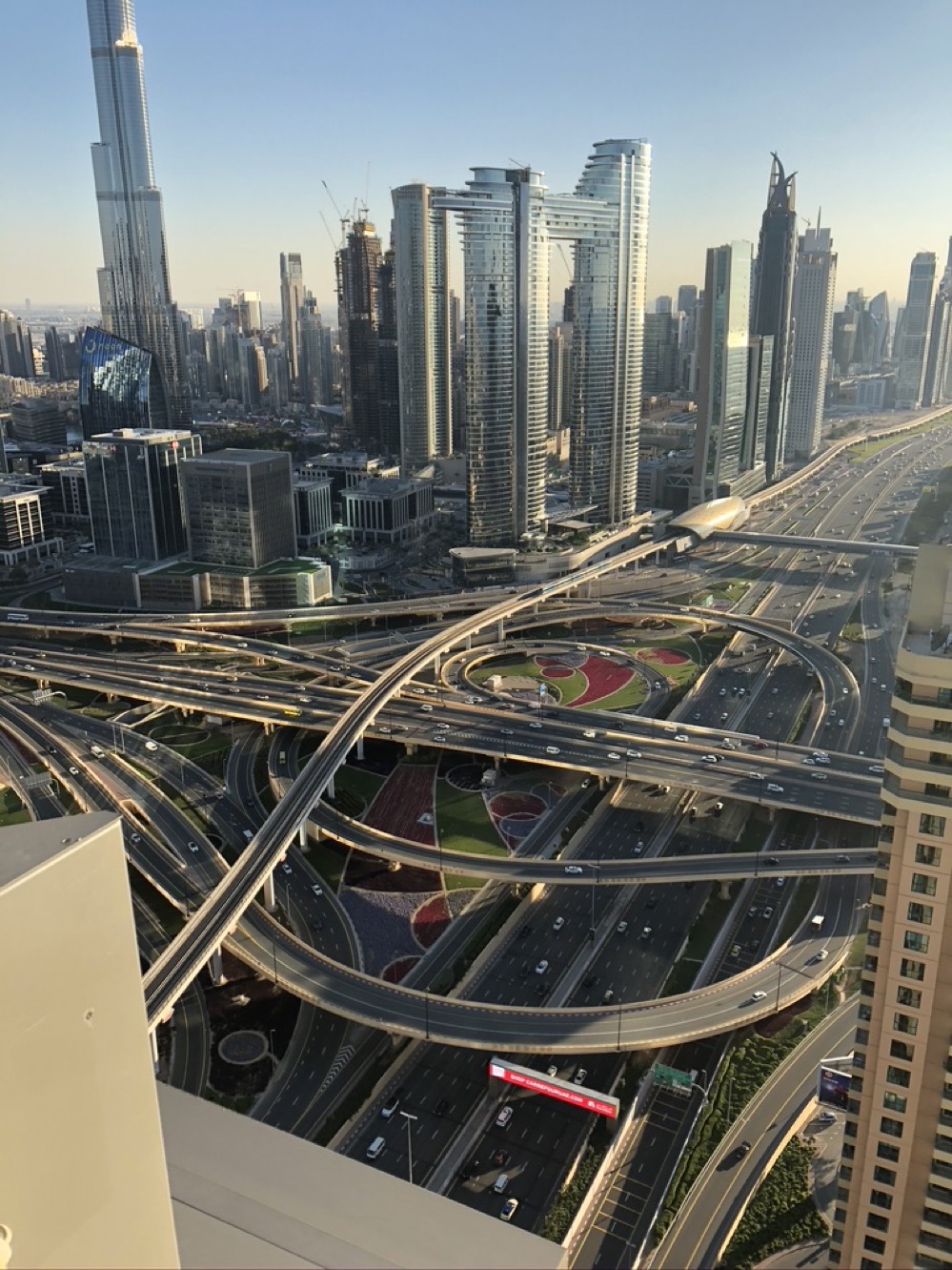
Coming out of our hotel we could have turned left towards the metro station 'Financial Centre'. The next stop would have been The Dubai Mall (which we can see in the above photograph taken from our hotel). So we would have taken a 1 km metro ride, and have still been left with a walk of 600 m to a side entrance to The Dubai Mall. The free hotel shuttle looked to be the easiest option.
Before actually entering the shopping area there were a few interesting features. One was a simple ticket that you could printout telling you that you were parked at P1 in the Grand Parking. Another was a bracelet that you could print out and put on a child, although I'm not sure how it worked. There was another machine that collected empty plastic bottles.
In any case inside The Dubai Mall the 'At The Top' was always signposted so it was not difficult to find our way to the entrance. However you do have to leave yourself some time to walk through The Dubai Mall and find the entrance.
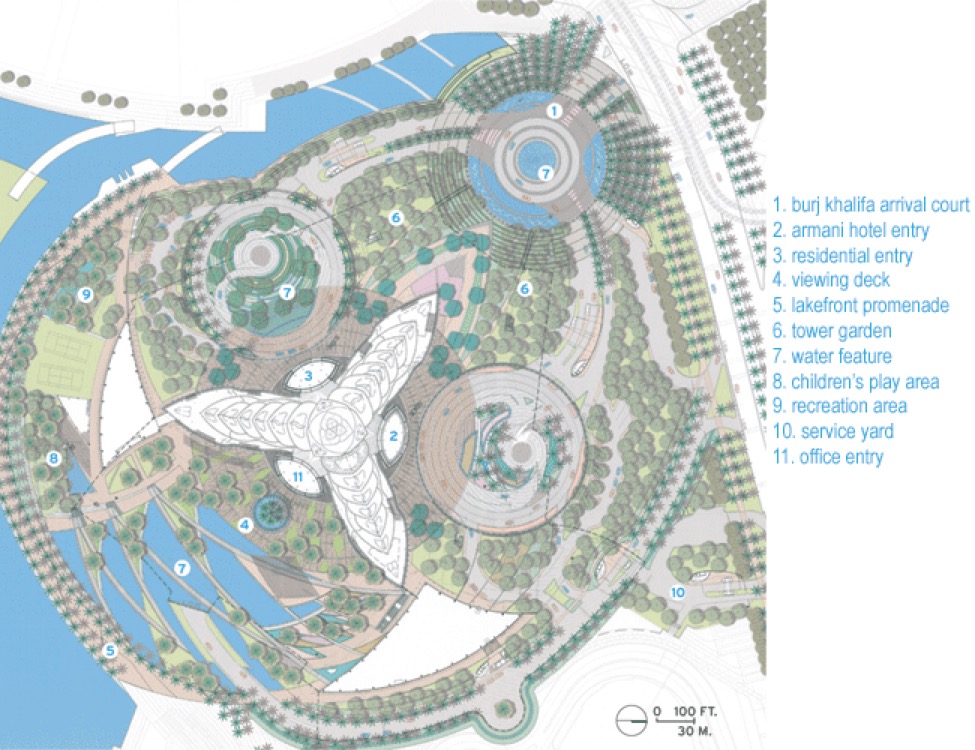
There is confusion on the Web. On the one hand the entrance to 'At The Top' is inside The Dubai Mall, however the entrance to the Armani Hotel and the restaurants in the Burj Khalifa are not in The Dubai Mall. You have to leave The Dubai Mall and walk round to the main entrance to the Burj Khalifa. So some people actually write saying you need to take a taxi from The Dubai Mall to the Burj Khalifa, others just say they are in the same place. But they are actually writing about two different entrances, and 'At The Top' is not a general purpose entrance to the Burj Khalifa.
Getting to 'At The Top'
Given the advice that we needed to arrive early we turned up at about 14:00 for the tour starting at 14:30. The voucher we printed from the web got us a priority queue, but there were still 3-4 people in front of us.
With the voucher we received entrance tickets indicating 'The Lounge - Hightea', but we did not have to prove our identity with a photo-ID.
There was a special 'The Lounge' waiting room, and perhaps 25 people were in our 'group'. The guide distributed sticky badges with VIP for those going up to 'The Lounge' and 'SKY' for those only going to level 148.
One of the major points of discussion on the web was the dress code. I have not found any official reference to the dress code for visitors to 'The Lounge'. However there are lots of assumptions made based upon general purpose dress code 'rules'. I must admit I fell into that same trap, e.g. extrapolating from one set of rules and applying them to another situation without any reason.
We were 'properly' dressed, i.e. more or less smart casual with proper shoes. However in our group there were tank tops, jeans, torn jeans, t-shirts, men in shorts, sports shoes, baseball hats, etc. So clearly there is no dress code for the visit to 'The Lounge', although I can't guarantee that hot pants and bikini top would be accepted.
The tour starts
We went through a security check where we had to empty our pockets, etc., and pass through a portal scanner.
After a brief introduction the guide took the group down 1 floor in a lift. Being a VIP group, we had priority access to the lift. Then there was an escalator that took us back up to what I presume was another part of the ground floor. Along the route there was an interesting presentation on the building of the Burj Khalifa, however we were not really left any time to fully appreciate it.
During this introductory route we were not actually in, or under, the Burj Khalifa. Only at the end of the walk were we finally under the building.
The next step was to take the lift to the 125 level. This took 60 seconds, but actually we did not feel much in the way of acceleration or movement.
One person in the group actually filmed the counter in the lift as it ran up to …. 123, 124, 125. Not sure why?
Then it was through a series of security gates to get access to the next lift that took us up to level 154.

The Lounge consists of a smallish outside terrace on level 154. This did not provide a 360° panorama, but did offer about a 270° view from the North, along the Southwest coast towards Dubai Marina, and around to the Southeast. What you could not see was the direction toward the Dubai International Airport.

Above we can see a view from the open observation terrace on level 154, however the mist affected visibility. Below we have a view from the closed area on level 152. This is affected by the mist and the glass window.
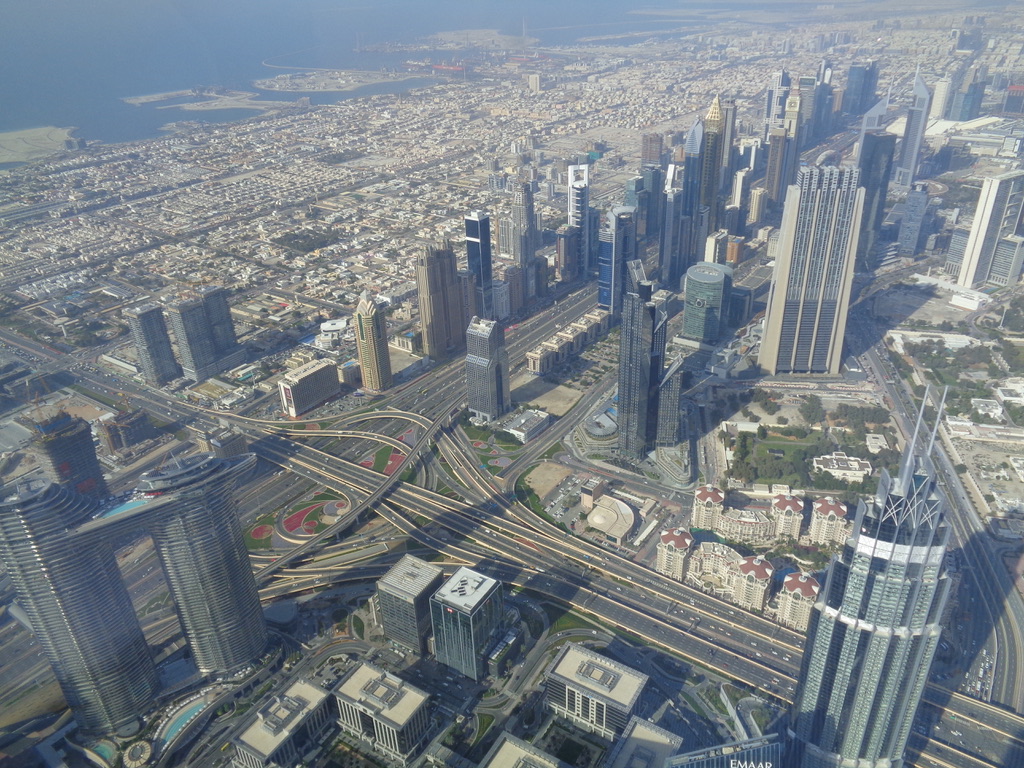
The Lounge continued on level 152 with a closed viewing space towards the north-east (direction airport). It was in this area that tea was offered with a small selection of sandwiches and cakes.

And that is really the end of the visit. Naturally you then have to take the lift back down to level 123, and another lift back to the ground floor.
And what about the famous Dubai 'fog'?
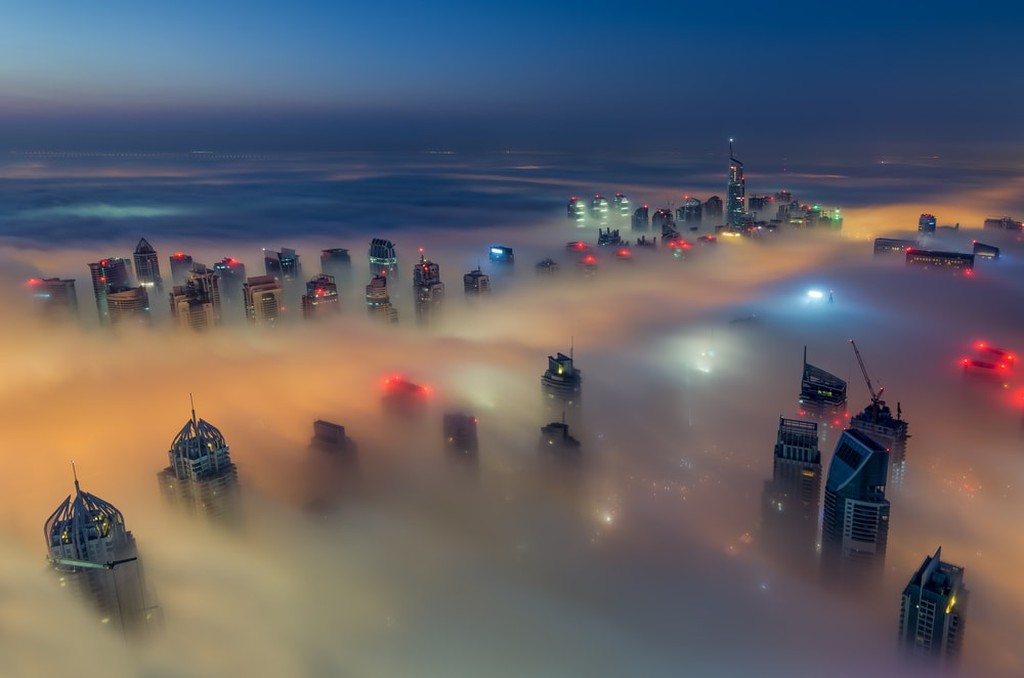
A few times per year (September to November) Dubai is covered in a fog blanket, which creates some fantastic views. At the end of the summer, air blown from the sea to the land is cooler, while the desert sands which are heated during the day, give off hot air at night. This hotter air rises and mixes with the cooler breeze creating air that is very humid and sticky. The humidity can get as high as 90% in the early morning, and with sand and dust (and pollution) in the air the mist can change into a fog. If the sun is not able to heat the ground, the layer of fog remains for a time. Visibility can drop to less than 50m, meaning that some flights are cancelled or diverted, and car accidents become a major concern.
Conclusion
The visit is certainly worth doing, but I did find the price a bit high for what is a very average 'tea experience' in the culinary sense. And I do wonder if the building is not even more impressive when seen from afar.

The Burj Khalifa
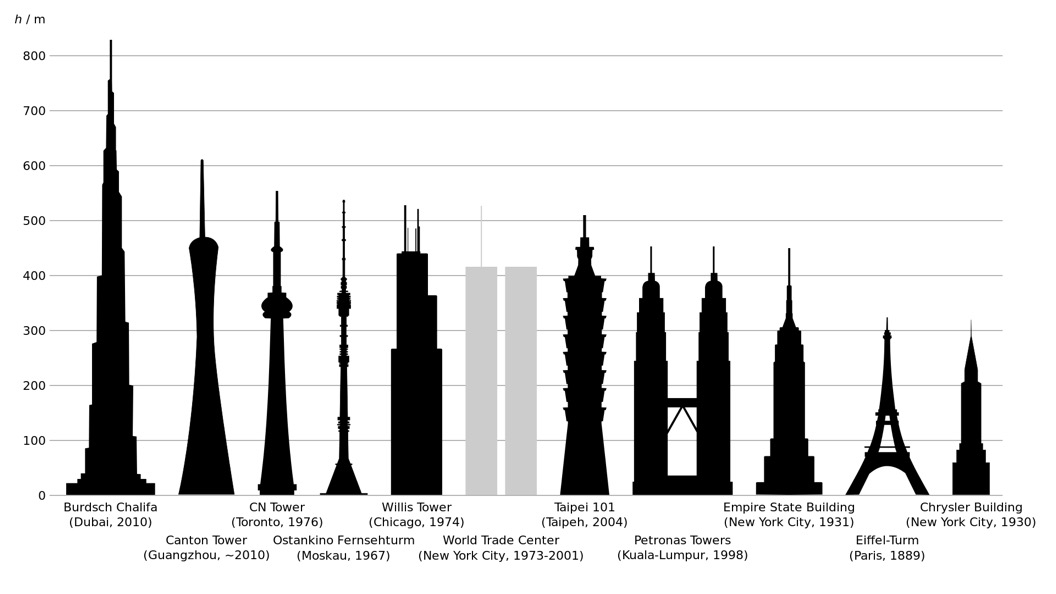
Now I'm going to turn to the building itself. Why was it built, how was it built, and who built it?
Let's start with the money. The Burj Khalifa is part of the flagship Downtown Dubai development with The Dubai Mall, parks, hotels and a $226 million fountain. The entire Downtown Dubai precinct is reported to have cost around $22.6 billion, with the tower alone costing $1.7 billion. Originally the tower was called Burj Dubai, but during the economic slump the development was bailed out by the ruler of the neighbouring Emirate of Abu Dhabi (they have 94% of the UAE oil reserves), and so it was renamed Burj Khalifa.
It's interesting to note that Downtown Dubai is built on a 500-acre site that was an abandoned military barracks.
And now let's have a look at some facts:-
Evacuation started in January 2004, and the tower was inaugurated on January 4, 2010.
The tower is 828 metres tall, or more that 200 storey but only 160 are habitable (535 metres for the highest occupied floor).
The buildings telescopic 'spire' is 12 metres in diameter and over 200 metres tall (in some texts this is called the pinnacle).
The four top floors under the spire are for communication and broadcasting.
The building weighs empty 500,000 tons.
Burj Khalifa utilised 330,000 cubic metres of concrete, 39,000 tonnes of steel reinforcement, 103,000 square metres of glass, and 15,500 square metres of embossed stainless steel.
Every 30 storeys there are 'mechanical zones' housing electrical sub-stations, water tanks and pumps, air-handling units, etc.
Approximately every 25 floors there is a pressurised, air-conditioned refuge in case of fire.
The tower took 22 million man hours to build, and involved over 12,000 people.
It has a total built-up area of 526,760 square metres, with the tower offering 280,000 square metres.
The building has 57 elevators, including a 504 metre tall service elevator (that also works as a fireman's elevator).
A total of nearly 950,000 litres of water is used every day.
At peak cooling times, the tower requires about 10,000 tonnes of cooling water per hour.
There is major problem with high humidity outside and inside the building, and the special air conditioning plant condenses 191,000 litres of water per day (it is used later for park irrigation).
The tower's peak electricity demand is 36 MW.
The entire electrical system is protected by low-voltage anti-condensation heaters in all the enclosed electrical switch panels.
There are 18 permanently installed window cleaning cradles, and it takes about 4 months to clean the whole exterior.
It has the worlds highest swimming pool, on level 76 (at 270 metres).
It is also home to the world's highest mosque located on the 158th floor.
There are four standby air-cooled chillers installed that provide backup cooling for the data centres installed in the 155th and 159th floors.
The consulting architect was Adrian Smith and the architects and engineers were Skidmore, Owings & Merrill. They employed 60 consultants, including 30 on-site contracting companies.
The building is mixed-use and is home to:-
900 apartments
37 floors of corporate suites
160 room Armani Hotel
144 suite Armani Residences
'At The Top' platforms
The 'At.mosphere' restaurant
Parking, offices and a health club, and including a park and water fountains.
The claim is that the design was an abstraction of a six-petalled American desert flower called Hymenocallis (spider lily). So the tower is composed of three elements or wings arranged symmetrically around a central core (elevators and mechanical closures). This design has been termed a 'buttressed core', which allows for a dramatic increase in height, whilst using conventional materials and construction techniques.
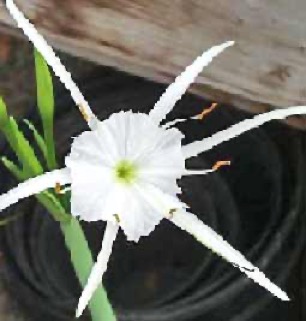

You can clearly see that this type of structure would be inherently stable, and provide an attractive floor plan for residential space. There are 26 levels where the cross section decreased as the tower rises.
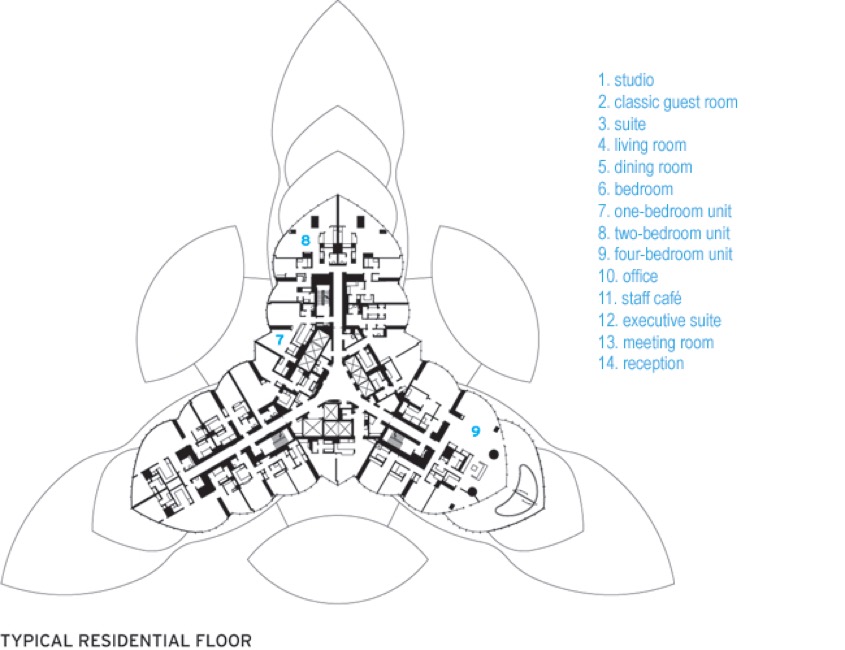
Within each wing, corridor walls extend from the central core towards the end of the wing, terminating in thickened cross walls referred to as hammerhead walls. The central core provides the torsional (twisting) resistance, while the wings provide the shear resistance and increased moment of inertia. The perimeter columns and the flat plate floor construction, with the outrigger walls, tie all the walls and columns together creating a resistance to lateral loads.
The reference to an 'outrigger' is similar to when you see a wheeled vehicle with folding out legs that provides additional stabilisation.
In this sense the entire building acts as one giant concrete beam cantilever coming out of the ground.
Cantilevers are usually seen as overhanging structures supporting a vertical weight, but in this case the idea is that the cantilever is a vertical structure embedded in the ground and resisting to horizontal winds.
Each piece of the vertical concrete (every gravitational force) is part of the giant beam, and resists the wind. At the end of the day it's the weight of the building that resists the wind. This creates a tower that is both stiff laterally and torsionally.
This reinforced concrete structure extends to level 156, and above that the next 230 metres is a steel braced frame (which in some texts is called a 'spire').
It may not appear so, but the building is extremely slender for its height. So despite all the calculations, etc. more than 40 models were tested in a wind tunnel. And the final orientation of the building was decided based upon the towers resistance to predominant winds in the region.
One impressive feature was that the initial tests in the wind tunnel were for a tower that was only about 60% of the final design. Yet at the end of the wind tunnel trails the tower had grown in height, but at the same time the effect of the wind on the structure had been reduced by 30% as compared to the shorter tower.
So as the tower rises the width changes. The architects defined the advantage of stepping and shaping the cross section of the building as designing to "confuse the wind". The wind vortaces never get organised because with each new tier the wind encounters a different building shape.
Excavation
One would expect that for the worlds tallest building you would find the worlds biggest foundations built in the worlds biggest excavation site. And you would be wrong.
The first step was to look at the geological data. Ground conditions in hot arid areas are often complex. What they found was some dense to loose granular silty sands from marine deposits, sitting on a very weak sandstone. Groundwater levels were less than 3 m below ground level. It was decided that a piled foundation would be the best. The designs were optimise for a centre-to-centre spacing of the piles at 2.5 times the pile diameter. A safety factor of just under 2 was calculated for vertically movement, and a safety factor of 5 for an overturning of the tower. Calculations also showed that there was a risk that the marine deposits and sand up to 3.5 m below ground level could liquefy during a seismic event. However, the tower foundations and raft were placed below that level.

In developing the final design for the foundations a number of additional problems had to be considered. Firstly, around a tall building there is often a 'podium' of smaller buildings which can produce a differential settlement between the high-rise and low-rise portions. Secondly, wind can impose high lateral forces, which can load the foundations, and especially the outer piles. Thirdly, the cyclic nature of the winds can impose a slow degradation of the foundations stability. Fourthly, seismic action can induce lateral forces and thus lateral motion on the ground support. Then there is the risk that wind-induced and seismic-induced loads can give rise to a resonance within the structure.
Using a simple supporting raft foundation is commonly adopted when building on a rock base. Another way could have been to build an underground raft in the form of an underground parking space. Placing a building on piles is used when the vertical and lateral loadings are significant. Then there is the option to build a thick basement slab in conjunction with piles.
Another issue concerning ground water was its composition. The ground water in Dubai has very high concentrations of chloride and sulphates, higher than in sea water. This makes the ground water highly corrosive, and forced the builders to implement numerous measures to protect the foundations. These measured included, specialised waterproofing, the addition of corrosion inhibitors in the concrete mix, and the fitting of a cathodic protection system utilising titanium mesh with an impressed current.
This last measure is designed to stop metals corroding in seawater. The mesh is usually a mixed-metal oxide catalytic coating sintered on to a titanium substrate. In large structures it's not possible to deliver a current that would provide protection from corrosion. What is used is an impressed current cathodic protection system which is usually embedded in the concrete at the time of construction. These system don't eliminate the salts that initiate corrosion, but they prevent the corrosion from continuing. An impressed current is a kind of cathodic protection, it turns the entire structure catholic in nature, i.e. a current receiver rather than a current provider. In this situation the anode becomes the 'sacrificial metal' and is eroded rather than the structural components in the foundations.
Foundations
The foundations started with 192 piles buried more than 50 metres deep. Each pile was about 43 metres long and 1.5 metres in diameter, and was made with self-consolidating concrete. Each pile could support up to 6,000 tonnes, but each was rated at 3,000 tonnes (see the photograph below for the pile test).

About 50,000 cubicle metres of concrete was used to create a concrete and steel foundation mat or raft 3.7 m thick and weighing more than 110,000 tonnes. The larger podium around the raft is 0.65 m thick and is supported on 750 bored piles (0.9 m is diameter and 30-35 m deep). Below we can see some of the different building phases.
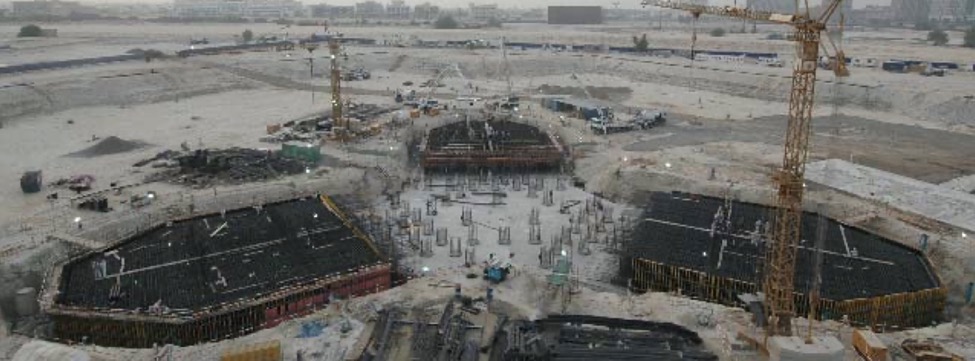


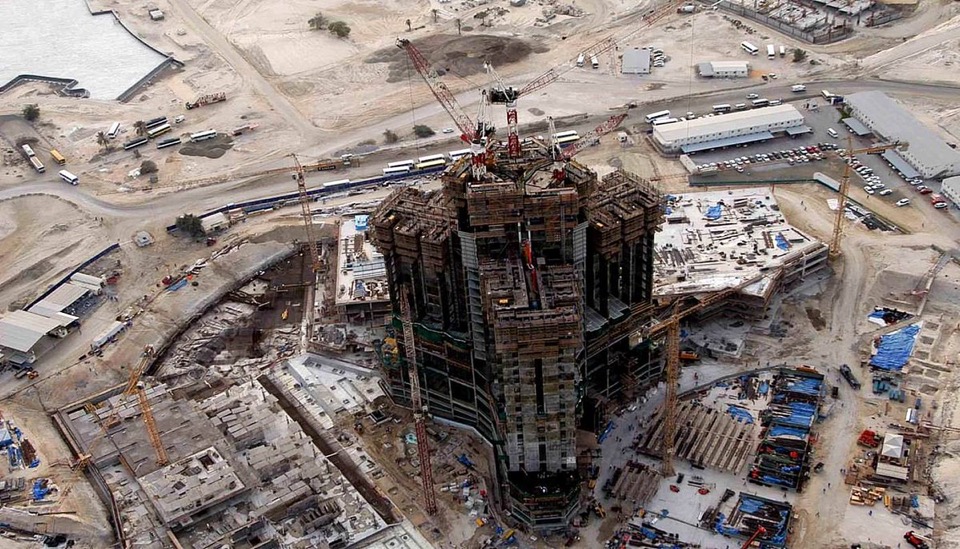
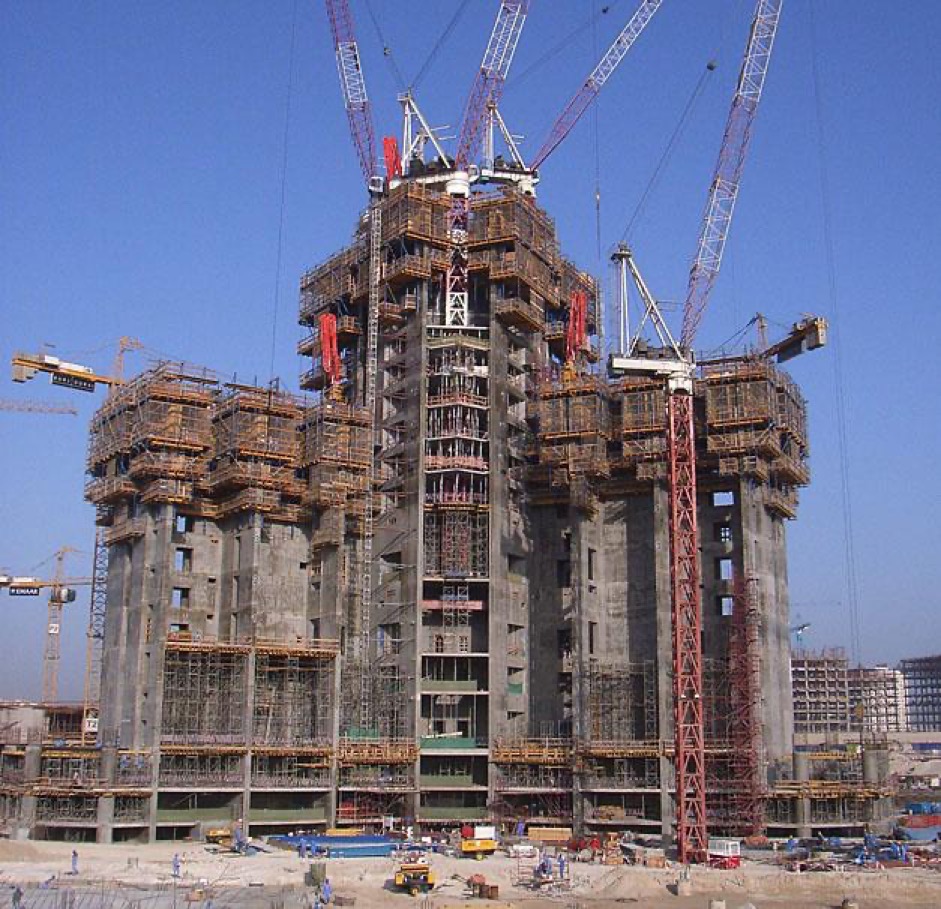
The building
One of the major innovations was that lots of sections were prefabricated on the ground and then lifted into place. At the same time the world's largest single-section cement pump was developed that allowed them to pump concrete to heights in excess of 600 metres.
As you might have guessed concrete is the basic building material for the first 156 floors. In building terms it is not sufficient to simply say concrete. In general terms the concrete used was Portland cement mixed with fly ash to which local aggregates were added.
High-strength concrete is not a different material from normal strength concrete, it just has a higher compressive strength than conventional concrete. This means it withstands higher loads and this feature is vital in the design of structures. The unit used for compressive strength is the Pascal (Pa), and given that atmospheric pressure is usually around 101 kPa, you can see that the compressive strength of concrete will usually be measured in mega-Pascals (MPa). Both conventional and high-strength concrete are fabricated from cement, water, a fine aggregate (e.g. sand) and coarse aggregate (e.g. gravel or crushed stone). High-strength concrete acquires its greater strength via (i) reducing the water-to-cement ratio, (ii) use of small course aggregate, and (iii) addition of fly ash or silica fume to increase bonding between the cement and coarse aggregate. Generally high-strength concrete starts at 60 MPa, but there are ultra-high performance concretes (UHPC's) that can exceed 150 MPa (generally 60 MPa concrete is shortened to C60, and 80 MPa to C80, and so on). Concretes above 60 MPa are usually employed for offshore structures, columns for tall buildings, long-span bridges and some defence applications.
For the Burj Khalifa a 60 MPa self-consolidating concrete (SCC) was used in the piling, whereas a 50 MPa SCC was used for the raft. For the tower itself both 60 MPa SCC and 80 MPa SCC were used.
In very simple terms 'self-consolidating concrete' (SCC) means that it is an extremely fluid mix which flows easily around formwork, flows into corners, etc., and is almost self-levelling and does not need tamping. As an example, the cement used for the raft included both fly ash and silica fume, wash crushed sand, dune sand, a fine aggregate, a viscosity modifying admixture and a superplasticiser which helps produce concrete with even less water content. One aspect is that the cement must dry and another is that it must cure, i.e. the concrete must have adequate moisture, temperature and time so that it develops its strength, stability, resistance to temperature variations, etc. For a concrete slab this might be 7 days, but for other applications this could mean 28 days, or more. In some cases this might involve spraying and fogging in order to stop plastic shrinkage and cracking during setting. For the Burj Khalifa raft the temperature inside the cement would rise to 55-65°C within about 5 days, and slowly cool to ambient temperature over a period of 2 months or more. I've read that to try to manage the concrete temperature the pouring was made at night, ice shards were added to the mix, and sun shades, wind breaks, and fogging was used to try a reduce plastic shrinkage cracking. Below we can see the building slowly growing.
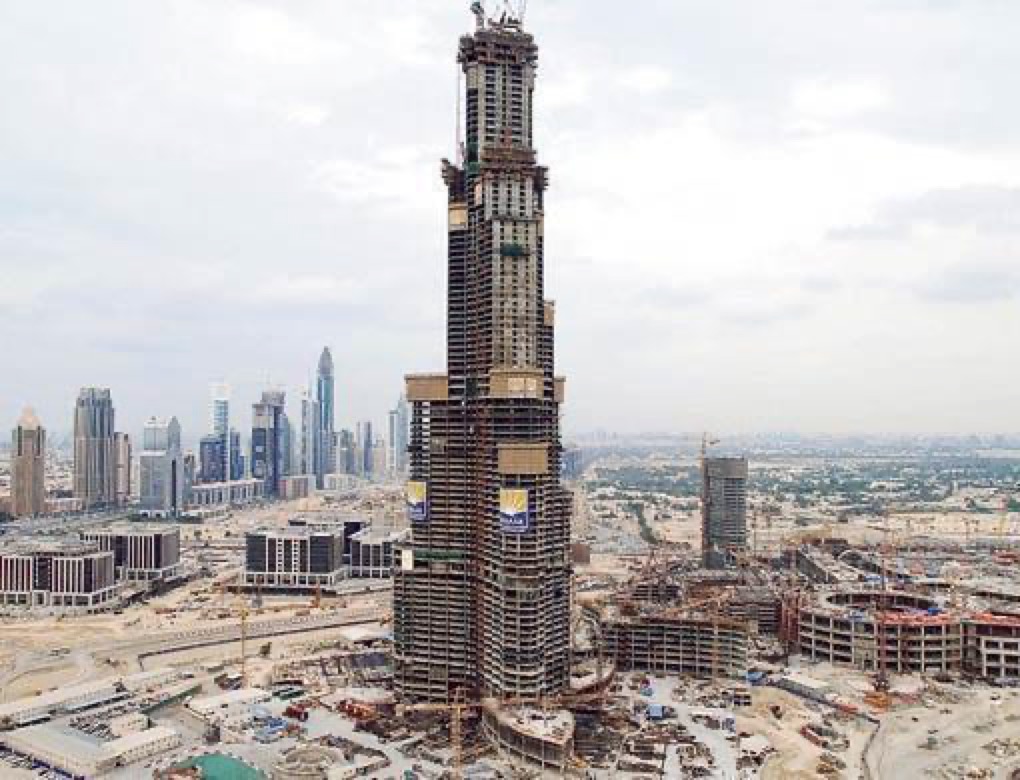
It's difficult to see, but the centre consists of hexagonal reinforced concrete core walls which provide torsional resistance similar to a closed tube. The central hexagonal walls are then buttressed by the wing walls and hammerhead walls which behave as the web and flanges of a beam to resist the wind.
Outriggers at the mechanical floors allow the columns to particulate in the lateral load resistance of the structure. Hence, all of the vertical concrete is utilised to support both gravity and lateral loads.
Outriggers are rigid horizontal structures designed to improve a buildings overturning stiffness and strength. They connect the building core or spine to distant columns at the perimeter. In tall buildings they improved its lateral stiffness and lateral load resistance capacity.
The wall thicknesses and column sizes were fine-tuned to reduce the effect of creep and shrinkage on the individual elements which compose the structure. To reduce the effects of differential column shortening, due to creep, between the perimeter columns and interior walls, the perimeter columns were sized such that the self-weight gravity stress on the perimeter matched the stress on the interior corridor walls.
Creep and shrinkage are two different concepts, but both can contribute to weakening a structure. Shrinkage in concrete occurs due to evaporation of water and bleeding. What that means is that the concrete is not cured properly. So the water in the concrete has evaporated too fast resulting in a reduction in the volume of the concrete, resulting in cracking. Creep is a type of permanent deformation occurring due to sustained loading (mechanical stress), which can be just the self-weight of the structure.
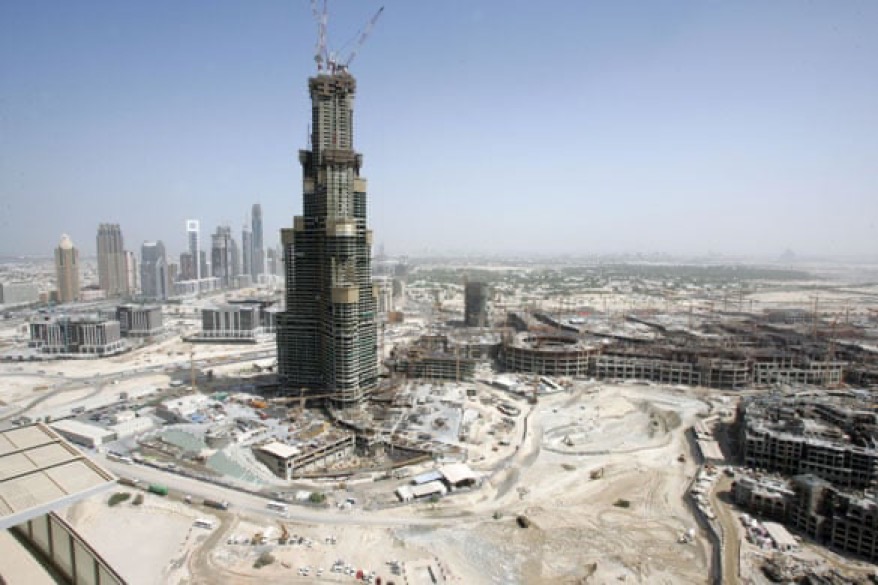
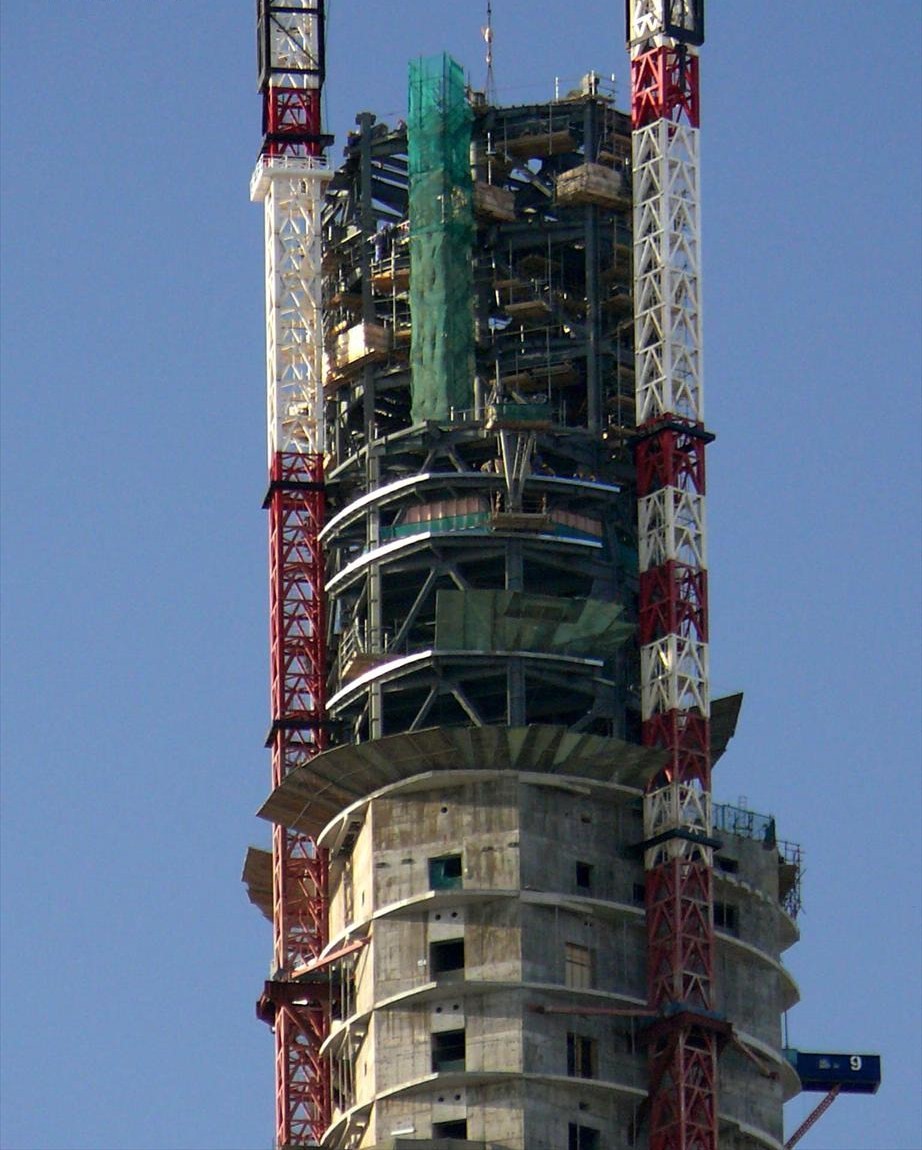
Lifts (Elevators)
As you can imagine lifts are an important feature of tall buildings. In fact there are more than 7 billion lifts journeys taken every day in buildings around the world. Buildings consume about 40% of the world's energy, and lifts account for anything between 2% and 10% of a buildings' energy consumption (in a day it can peak at 40%). Fortunately the latest generation of lifts consume about 25% less and occupy about 30% less space. For example, AC motors are replacing DC motors, new types of geared or gearless systems power variable speed lifts, lifts no longer need machine rooms, LED lighting is now used, and some lifts now have regenerative drives. With very tall buildings the lift rope can represent 70% of the lifts weight, and if the rope gets too long it can't support its own weight. For example a lift rated at 2 tonnes travelling over 500 metres can have a total weight of 27 tonnes. There are lifts where a 50 tonnes lift cable is moving only 21 people. The shift is increasingly to thin fibre cables, or even cables with carbon-fibre cores. These can produce a 90% reduction in weight. There are even systems now that can run two cabins in the same shaft, naturally keeping a safe distance between them. Other options include the double-decker lift cabin.
In the Burj Khalifa there are 57 lifts, two are double-deckers used for the observation decks (one travelling at 10 metres/second). There are express lifts that go to levels 43, 76, and 123, and then there are local lifts that service the intermediary levels. And 25 of the lifts do not have machine rooms, use belts instead of cables, and gearless drives instead of bulky motors. There are large service lifts that can be used if the tower needs to be evaluated (the lifts have 'lifeboat features'). And there are fire-resistance safety floors linked to fire-resistance stair shafts.
Cranes
An additional, often overlooked, challenge were the cranes. Building them as the building grows is a far smaller problem than removing them once the building is finished. Three 25-tonne cranes were used to bring material up to the 156 level. An added problem was that the floor plan grew smaller as the building grew. One of the cranes was dismantled, and rebuilt from the 99th floor as a recovery crane. As the floor plane became increasingly small, a second crane was removed. A second recovery crane was installed on level 159. The two recovery cranes were then used to removed the final 700 m tall crane. What happened was that the tallest crane removed parts of itself down to level 159. The recovery crane then dismantled the rest. Then obviously the recovery crane dismantled itself until it arrived at level 99, where the first recovery crane continued the work. The final recovery crane at level 99 was then dismantled.
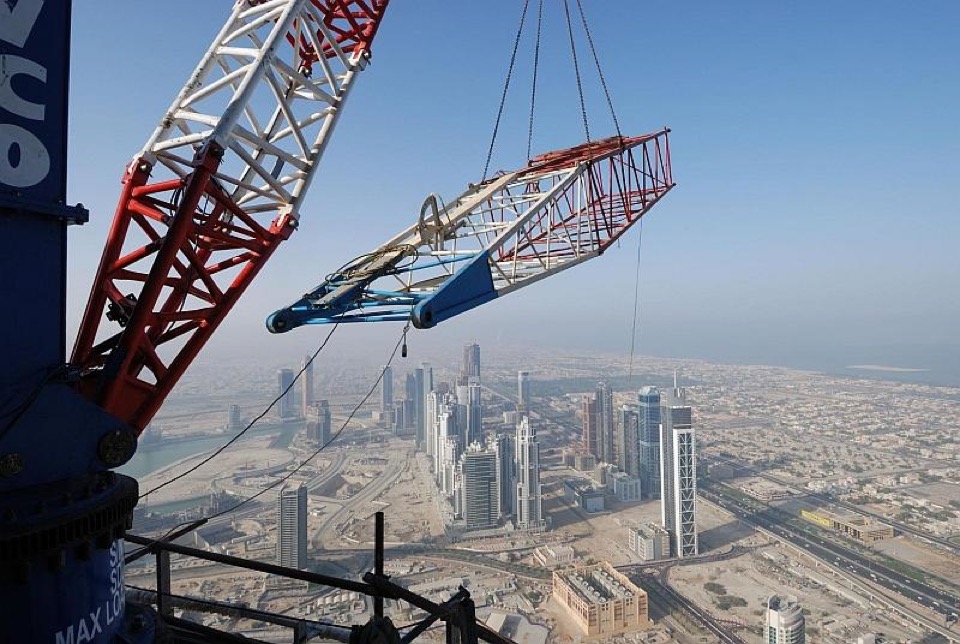
And here we have a view from the camera at the top of the 700 m crane.
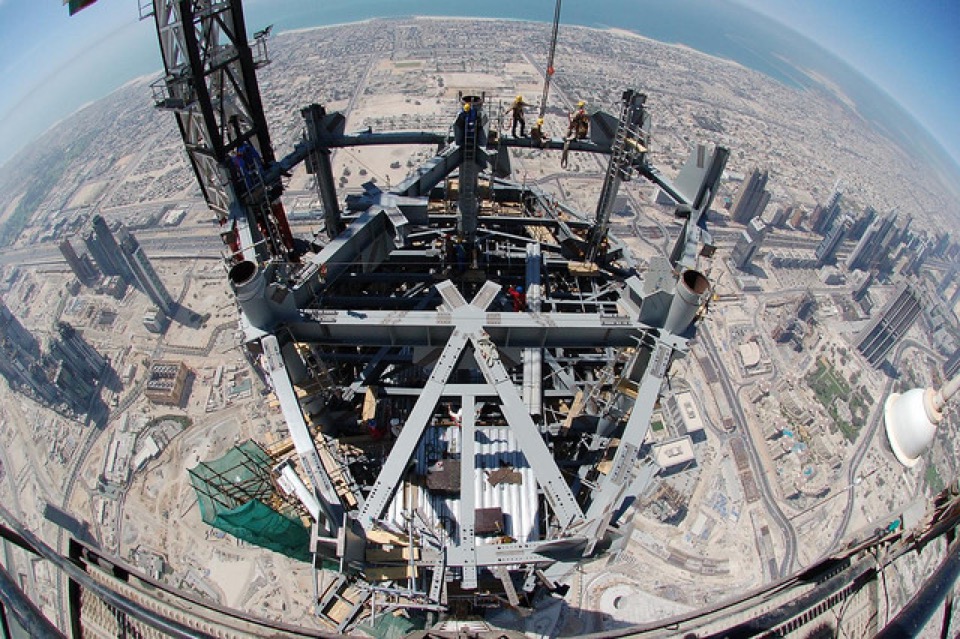
And here we have a view from the pinnacle. The top section of the tower consists of a structural steel pinnacle utilising a diagonal braced lateral system.

In some texts there is confusion between 'spire' and 'pinnacle', and some people just lump them together and call them a 'spire'. The concrete structure stopped at level 159 (585 m). They then started to bring up about 4,000 tonnes of structural steel to build the 'spire'. This is a 244 m structure that adds 'vanity height' to the building. It is almost empty, but it houses four floors of communications equipment. They also bought up a 350 tonne 200 m long pinnacle (450 tonnes with cladding and base fixation). The pinnacle is in fact a pipe made of rolled steel with a diameter of 2.1 metres. The pinnacle was lifted to level 156 in 5 metres sections and then assembled inside the spire.
And finally, we have a view of a team who built a base jump platform on the top of the pinnacle. It may look stable, but in fact it can sway by about 1 metre. Still they are quite experienced, since they also do the window cleaning, and install the New Year fireworks. Here is one of the base jumps, and now base jumping from different Dubai buildings has become common place (but if you really like height have a look at this).

Now that we have arrived at the very top, that's it! Not quite, we have forgotten one very last, but very important, feature. What could it be?
Lightning protection, of course! Different cloud formations in the region can be as low as the 500 m. However the only really important type of cloud is the Nimbostratus, which can produce occasionally low intensity lightning. The ones to look out for are the Middle Level ones up to 2,000 m above sea level, and Vertical Nimbostratus clouds. With these types of clouds the most likely place for a discharge is on the top of the structure. Thunderstorms may occur as a side effect of the Indian monsoon. As with any lightning rod, it comprises of an air terminal, a down conduction, and an earth. The air terminal is installed on a mast which is directly welded to the metallic structure of the pinnacle. You can just see it in the below photograph, and I leave it to the reader to identify the actor sitting next to the air terminal.
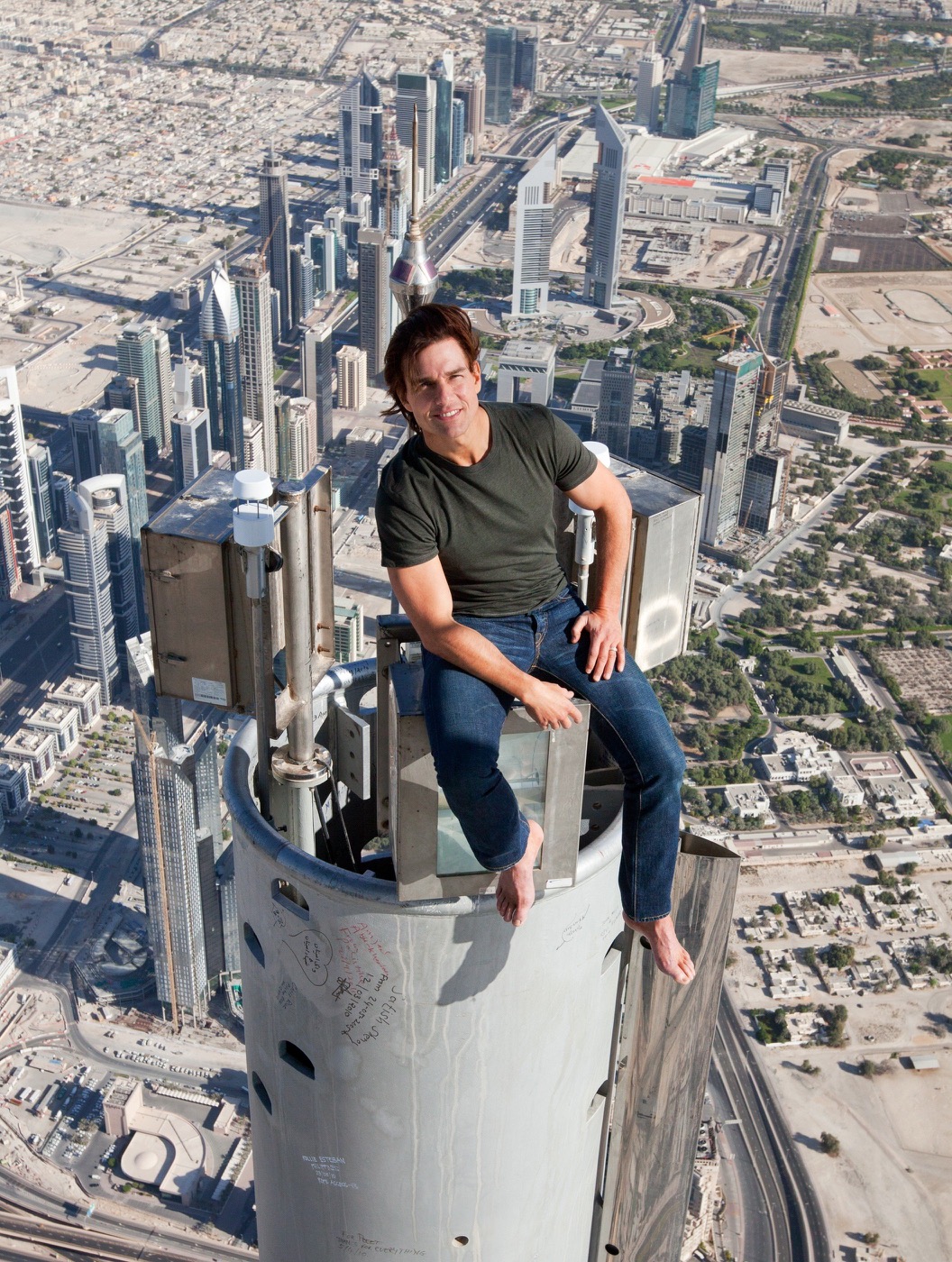
What we see is in fact a so-called 'ESEAT' (early streamer emission air terminal) which is an active non-electronic based lightning protection based upon a corona discharge technology that uses the naturally occurring electrical field to complete the release of an upward dart. The idea is that the ESEAT actually helps create an upward leader that 'attracts' a strike. The lightning current then follows a low impedance path through a down conductor to earth.
Lessons learned
One of the key lessons is the way wind vortices are handled. The idea now is to build a constantly tapering tower where the wind vortices can never develop because of the changing building width. In addition the gravitation load would flow smoothly to the ground, uninterrupted by the different step-backs in the tower diameter.